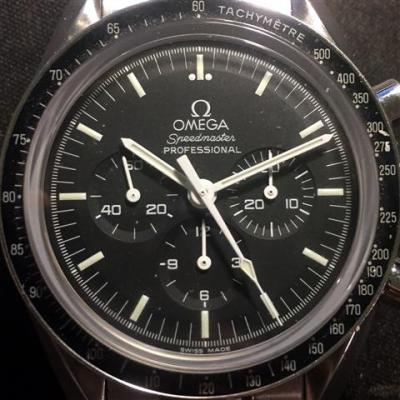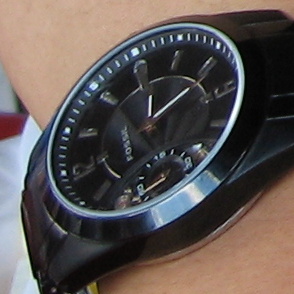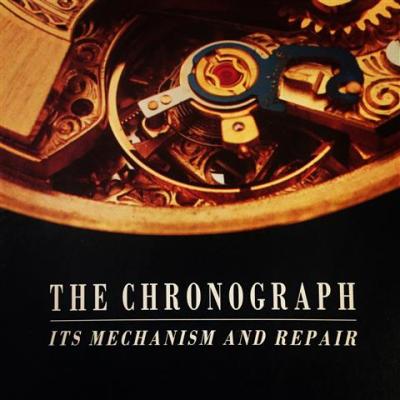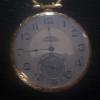Leaderboard
Popular Content
Showing content with the highest reputation on 04/02/17 in all areas
-
i got a job,when 18,in a jewelry store in my home town. the owner,turned out to be a cmw and cmc. he agreed to take me on as appretice. after spending time as a clerk, sweeping up under the lathe benchs, hand filing and theroy, disassembly, cleaning, polishing,assembly, i had spent two yrs. found an appreticeship program (for 5 yrs) sponsed by NCWA license board.I did my (ojt) in the NC mts. the owner of the store, she was 5 generation CW, her dad CMW,CMC,her mother CMW, husband CCM,both her son and daughter worked there. I lived with the family,in their home,(24 hrs.per day.I got a job at the old waltham factory.building the A-13A,8 day aircraft clock,for the goverment. I did final assembly,final timing(30 sec in 8 days) !!! a lot of balances to poise. by the way it was done with hand calipers, you vibrate the calipers with tweezers, the heavy point allways falls down. the last watmkrs guild was in waltham MA, I loved it all,a master was so much more than a profesional,at least to me.I still love fine mechinal works. thank yall,for letting me participate in your group oldwamkr2 points
-
That's a beautiful movement with some really interesting features, see more here http://watchguy.co.uk/guest-post-lemania-273000-the-moon-watch-caliber-321s-lesser-known-cousins/ If the watch is gaining time, then the problem will not be with the canon pinion, it is more likely to be an issue with the hairspring / balance. That "anti-catch" feature on the regulator is pretty unusual. You will need good magnification to see all this (x10 minimum), but make sure that the hairspring only touches between the regulator pins and doesn't touch the balance, anti-catch pins or itself anywhere else. I assume that the watch kept approximate time before you started? Sometimes we see watches with an incorrect part fitted which can cause large errors. "A" = Avance; move the lever this way to make the watch go faster "R" = Retard; move the lever this way to make the watch go slower. Sometimes you see F & S also, but the important thing to remember is that if you make the effective spring length longer then the watch will run slower. However, you will not have enough adjustment on the regulator to take out 2 hours in 12 hours2 points
-
If you work a lot with old watches that may have radium then investing in a geiger counter is the correct way to answer that question. Radium has a biological half life of 90 to 120 days that's for half of the radium in a system to be removed for the radium that's not taken into bones. A small amount shouldn't be too much to worry about. It is partially soluble in water so the liquid in the ultrasonic cleaner is now technically contaminated. Explaining contamination and cleanup would be a wall of text but here's a video I found that illustrates how seriously we take contamination in labs. I have the use of a TRIGA research reactor for my physics labs. My job sometimes has me working at nuclear facilities so having the education and radiation worker II cert lets me work with things that otherwise wouldn't be allowed. Only way to know for sure is a geiger counter with a pancake tube. As for the liquid any contamination should be only trace from the amount on watch hands. If you want peace of mind then put on gloves, pour it down a sink where you don't handle food or anything goes into your mouth and leave the water running for about 15 minutes. You can use the time to scrub the inside of the ultrasonic cleaner with soap and water a few times then remove the gloves and wash your hands up to any point you made contact a couple of times. Low-level liquid radioactive materials are allowed to be disposed of in drains. And whatever you do, do not use beryllium tipped tools near exposed radium. When an alpha particle hits beryllium it creates neutron radiation. Neutron radiation can latch onto certain atoms and create radioactive isotopes, in layman's terms they're kinda like little radioactive hand grenades that can also make other things radioactive. Remember the 'radioactive boy scout' who had his back yard turned into a superfund radioactive cleanup site? He used beryllium and radium he collected off old watches and clocks to be the neutron source for his little reactor. It's very small amounts so it's not really that dangerous but if someone say left a beryllium tipped tool on a radium lume for the weekend they could come back to more radioactive material. It's best to just have the practice of keeping those tools away from radium to begin with.2 points
-
Good afternoon everyone! I couldn't find an introductions board so I figured the general board would be a great place to start. First off, my name is Caleb and I am from Brooklyn, NY. My first wristwatch purchase was black stainless steel Fossil from 2007. It was about $100 USD and, at the time, it was significant amount of money. I really liked the watch because it was very low-key and it looked more expensive than it really was. I had it for about two years, until I left it in someone's dorm room and never found it. That was the last time I wore a watch for a significant period of time. Fast foward to the end of 2012, five years after my first purchase. I was hitting my two year mark working as test engineer at a company in Garden City, NY that manufactured heat exchangers for military and commercial aircraft. I finally was able to afford nice clothes for the first time in my life, but I was never able to find a watch that I really enjoyed; there were too many to choose from and I could not decide which one I liked because I liked too many of them. I started doing some research (ie. a lot of Googling). It started off at this forum that spun off from another gaming forum that I frequented when I was in middle (secondary) school) and it ultimately brought me to Watchuseek. After perusing Watchuseek for a suprisingly short amount of time, I discovered the watch I wanted to purchase: an Omega Speedmaster Professional. Its history intrigued me; I worked as a test engineer in the aerospace industry, so I was familiar with all the qualification tests that the Speedmaster was subjected to back in the 1950s and 1960s - high temperature, low temperature, humidity, vibration, shock, thermal cycling, pressure cycling, etc. It was the perfect memento to end my tenure working in the aerospace industry. I haven't worn a watch in years nor did I know anything about wristwatches. I knew nothing about the brands nor did I really care for them. The last one I purchased, in retrospect, was a paltry sum of $100 USD and I had thought that was expensive. I was expecting to spend around $1000 to $1500 on my first proper wristwatch so I experienced a bit of a sticker shock when I discovered the price of the Speedmaster Professional. Long story short, I bit the financial bullet and purchased the 3573.50 (the one with the sapphire crystal and caseback) from Ace Jewelers in Amsterdam. The watch was delivered to me on December 21st 2012. For those who do not recall, that was the date when the Mayan calendar ended. An asteroid was suppose to crash into Earth, ending all of human life as we know it. The world was in a frenzy, despite the sheer impossibility of such an event happening. It was a bizarre coincidence (and the first of many) as a new owner of a Speedmaster Professional. A few days later, I was attending my friend's Christmas Party. At one point of the party, I had noticed that the watch had stopped. I wounded it up all the way and it starting going. A few days after that, I was attending another friend's New Years Party. At the stroke of midnight, I had checked my watch and noticed that it had stopped dead. There was something clearly wrong. The next few months became an ordeal. I had brought my watch to the Omega Boutique in New York, twice. I had asked them to wear the watch and they will immediately find that there is a problem, but I am assuming they did not listen to my recommendation. They had my watch for nearly two months, both times they failed to correct the problem, let alone replicate the problem. To add insult to injury, as they were handing the watch to me one final time, the only solution they offered was that I must have been winding it incorrectly. Seriously, the people in the Omega Boutique sat me down for 15 minutes to teach me how to wind a brand new watch. Finally, I had shipped it back to Ace Jewelers in Amsterdam. They initially failed to replicate the problem (I had to tell them to wear the watch and they soon discovered that there is something clearly wrong with it), but ultimately shipped it to Omega, had the problem corrected, and then shipped it back to me. It has been nearly two years since then and the watch is still going, although it jumps ahead a few minutes after a few weeks. As a result of this ordeal, I became incredibly disinterested in Omega as a brand, but as an upside, I became incredibly interested in mechanical wristwatch movements; one could say this was the silver lining to that mess. I didn't know where to start so I started doing research on my troublesome watch. I purchased this book by B. Humbert, The Chronograph - Its Mechanism and Repair. I have tried to look over it extensively. It is a great book, but it is like attempting to read a car repair manual for fun. I managed to get a hold of Chicago Watchmaking School's Watchmaking Guide and I am starting to read it. Again, it is like reading a car repair manual for fun. I'll glance through them every now and then, but as of now, they are not capturing my attention. Then I discovered Mark Lovick's YouTube videos. I have only one word to describe them: Fantastic. Seriously, I watch them before I head to bed at night. I am at that stage in between research and actually purchasing a movement to tinker around with. The first step I plan on taking is purchasing the basic tools and a scrap pocketwatch movement for disassembly and reassembly; I'll be following the Chicago Watchmaking School's Watchmaking Guide as it seems to be very structured. I would love to hear other people's input, their history, how they got involved in watchmaking, where they are currently, and where they plan on going. I look foward to speaking with all of you!2 points
-
As I'm progressing in my knowledge from just being able to regulate and adjust to minimize beat error I've been looking at the 7S26 that I have with my Seiko 5 beater watch. I've heard numerous mentions of being careful that you don't break the plastic gears, particularly in vintage watches. There is a solution for that. With a bit of CAD skills you can print replacement gears and parts. The cheaper filament based printing isn't precise enough but laser based SLA can print features down to 100 microns it should be sufficient for all but the tiniest parts. More than just gears and components it can also be used for custom tools within the limits of the materials used. The Form 2 is the printer I would look at unless you want to step into commercial pricing.1 point
-
You could always try the old "super glue a nut to the case back and use a spanner trick". It generally succeeds when the Jaxa style wrench fails1 point
-
Nice looking movements those Lemania 3000 . But the hairsprings are difficult to get right? Brequet overcoil type hairsprings are almost impossible to get perfect? Check the beat error?1 point
-
I suppose they were as good as anyone else's, Dueber had some pretty fancy looking ones!1 point
-
I definitely am not an authority on Hazmat procedures . In the past , when Hazmat started to be a concern , when we would have to drill a hole in suspected hazmat materials such as asbestos painted walls and floor tiles , we would use shaving cream around the area we were drilling to capture the dust and particles so they wouldn't float in the air we were breathing . I'm thinking that maybe this method could be used with the radium lume ???1 point
-
1 point
-
1 point
-
Are they completly new? They are usually very tight and hard to put on the first time? Specially the sub hands? I tried but i broke two of them So ended up going to a well known Omega watchmaker for help with the hands? Take some practice to do it right? You also need a special movement holder that supports the wheels and pinions.1 point
-
So why was the MS slipping? could you post a link to the end of the story?1 point











